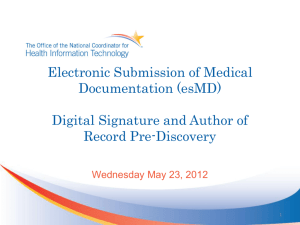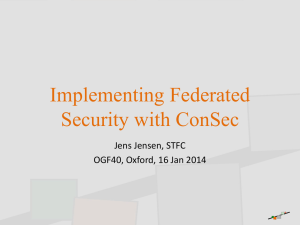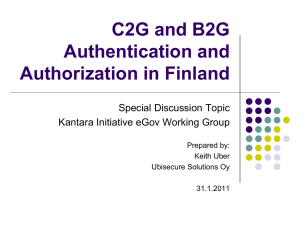SAML and XACML Overview Prepared by Abbie Barbir, Nortel
advertisement
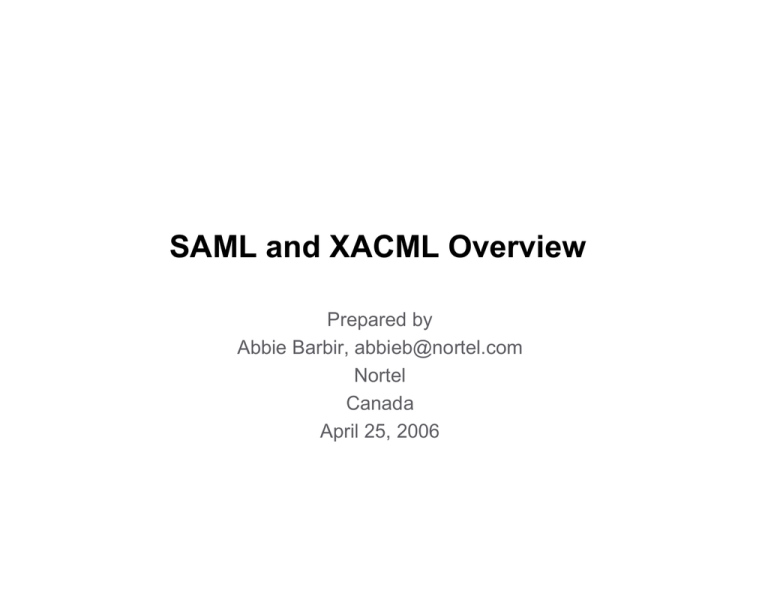
SAML and XACML Overview Prepared by Abbie Barbir, abbieb@nortel.com Nortel Canada April 25, 2006 Acknowledgements Some slides are provided by > Eve Maler, Sun Microsystems > Hal Lockhart, BEA 2 Agenda > SAML History and Overview > SAML 2.0 Features > Status in ITU-T > XACML History and Overview > XACML 2.0 Features > Status in ITU-T 3 SAML Overview and History • SAML: Security Assertion Markup Language • A framework for the exchange of security-related information between trusting parties • The key standard for federated identity systems • Supports many real-world business scenarios • Widely used today for cross-domain single sign-on • OASIS Security Services Technical Committee (SSTC) • SSTC manages SAML development 4 SAML Timeline SAML 1.0 Completed: May 2002 OASIS Standard: November 2002 Liberty 1.1 Completed: Jan 2003 SAML 1.1 Completed: May 2003 OASIS Standard: September 2003 Shibboleth OpenSAML 1.0 Completed: June 2003 Shibboleth OpenSAML 1.1 Completed: August 2003 Liberty ID-FF 1.2 Completed: Oct 2003 SAML 2.0 Completed: January 2005 OASIS Standard: March 2005 5 SAML 2.0 Specification Suite • Conformance Requirements • Required “Operational Modes” for SAML implementations • Assertions and Protocols • The “Core” specification • Bindings • Maps SAML messages onto common communications protocols • Profiles • “How-to’s” for using SAML to solve specific business problems Metadata Configuration data for establishing agreements between SAML entities Authentication Context Detailed descriptions of user authentication mechanisms Security and Privacy Considerations Security and privacy analysis of SAML 2.0 Glossary Terms used in SAML 2.0 6 SAML Concepts 7 Terms and concepts 1 Subjects Entity (system entity): An active element in computer/network system Principal: An entity whose identity can be authenticated Subject: A principal in the context of a security domain Identities Identity: The essence of an entity, often described by one's characteristics, traits, and preferences Anonymity: Having an identity that is unknown or concealed Identifier: A data object that uniquely refers to a particular entity Pseudonym: A privacy-preserving identifier Federated identity: Existence of an agreement between providers on a set of identifiers and/or attributes to use to refer to a principal Account linkage: Relating a principal's accounts at two different providers so that they can communicate about the principal 8 Terms and concepts 2 More Entities Asserting party (SAML authority): An entity that produces SAML assertions Identity provider: An entity that creates, maintains, and manages identity information for principals and provides principal authentication to other service providers Relying party: An entity that decides to take an action based on information from another system entity Service provider: An entity that provides services to principals or other entities 9 How these entities interrelate Most of the SAML and ID-FF use cases are eyeballoriented But some backchannel (SOAP and other) communication takes place in service of this 10 SAML assertions > Assertion is a declarations of fact • according to someone > SAML assertions contain one or more “statement” about “subject” (human or program): • Authentication statement: “Joe authenticated with a password at 9:00am” • Attribute statement (which itself can contain multiple attributes) • Joe is a manager with a $500 spending limit • Authorization decision statement (now deprecated) • You can extend SAML to make your own kinds of assertions and statements > Assertions can be digitally signed 11 Example: Common Assertion Portions <saml:Assertion xmlns:saml="urn:oasis:names:tc:SAML:2.0:assertion" Version="2.0“ IssueInstant="2005-01-31T12:00:00Z"> <saml:Issuer> www.acompany.com </saml:Issuer> <saml:Subject> <saml:NameID Format="urn:oasis:names:tc:SAML:1.1:nameidformat:emailAddress"> j.doe@company.com </saml:NameID> </saml:Subject> <saml:Conditions NotBefore="2005-01-31T12:00:00Z" NotOnOrAfter="2005-01-31T12:00:00Z"> </saml:Conditions> ... statements go here ... </saml:Assertion> 12 Example: Authentication Statement <saml:Assertion ... common info goes here ... > ... and here ... <saml: AuthnStatement AuthnInstant="2005-01-31T12:00:00Z" SessionIndex="67775277772"> <saml:AuthnContext> <saml:AuthnContextClassRef> urn:oasis:names:tc:SAML:2.0:ac:classes: PasswordProtectedTransport </saml:AuthnContextClassRef> </saml:AuthnContext> </saml:AuthnStatement> 13 Authentication context classes 9 Internet Protocol 9 Internet Protocol Password 9 Kerberos 9 Mobile One Factor Unregistered 9 Mobile Two Factor Unregistered 9 Mobile One Factor Contract 9 Mobile Two Factor Contract 9 Password 9 Password Protected Transport 9 Previous Session 9 Public Key – X.509 9 Public Key – PGP 9 Public Key – SPKI 9 9 9 9 9 9 9 9 9 9 9 9 Public Key – XML Signature Smartcard Smartcard PKI Software PKI Telephony Nomadic Telephony Personalized Telephony Authenticated Telephony Secure Remote Password SSL/TLS Cert-Based Client Authn Time Sync Token Unspecified 14 Example of an attribute statement <saml:Assertion ... common info goes here ... > ... and here ... <saml:AttributeStatement> <saml:Attribute NameFormat=“http://smithco.com”> Name=“PaidStatus” <saml:AttributeValue> PaidUp </saml:AttributeValue> </saml:Attribute> <saml:Attribute NameFormat=“http://smithco.com”> Name=“CreditLimit” <saml:AttributeValue xsi:type=“smithco:type”> <smithco:amount currency=“USD”> 500.00 </my:amount> </saml:AttributeValue> </saml:Attribute> </saml:AttributeStatement> </saml:Assertion> 15 Artifacts A small, fixed-size, structured data object pointing to a typically larger, variably sized SAML protocol message can be embedded in URLs / conveyed in HTTP messages Allows for “pulling” SAML messages as opposed to “push” SAML defines one artifact format but you can roll your own 16 Protocols Assertion query and request Query for assertion based on simple reference, subjectmatching, or statement type Authentication request SP requests a fresh authn assertion that adheres to various requirements (specified by means of Authentication Context) Artifact resolution (“meta-protocol”) Dereferences an artifact to get a protocol message Name identifier management IdPs and SPs inform each other of changes to their mutual understanding of what a principal's name is Name identifier mapping Privacy-preserving way for two SPs to refer to the same principal Single logout Signals to all SPs using the same session to drop the session 17 Bindings SOAP Basic way for IdPs and SPs to send SAML protocol messages Reverse SOAP (PAOS) Multi-stage SOAP/HTTP exchange that allows an HTTP client to send an HTTP request containing a SOAP response HTTP redirect Method to send SAML messages by means of HTTP 302 HTTP POST Method to send SAML messages in base64-encoded HTML form control HTTP artifact Way to transport an artifact using HTTP in two ways URL query string and HTML form control URI How to retrieve a SAML message by resolving a URI 18 Profiles Web browser SSO SSO using standard browsers to multiple SPs: profiles Authn Request protocol and HTTP Redirect, POST, and artifact bindings Enhanced client and proxy (ECP) SSO using ECPs: profiles Authn Request protocol and SOAP and PAOS bindings IdP discovery One way for SPs to learn the IdPs used by a principal Single logout Name identifier management Profiles the NIM protocol with SOAP, HTTP redirect, HTTP POST, and HTTP artifact bindings Artifact resolution Assertion query/request 19 SAML Status in ITU-T > Currently X.websec-1 > In Q9/17 > Text is stable and reviewed 20 Agenda > XACML History and Overview > XACML 2.0 Features > Status in ITU-T 21 XACML History First Meeting – 21 May 2001 Requirements from: Healthcare, DRM, Registry, Financial, Online Web, XML Docs, Fed Gov, Workflow, Java, Policy Analysis, WebDAV XACML 1.0 - OASIS Standard – 6 February 2003 XACML 1.1 – Committee Specification – 7 August 2003 XACML 2.0 – OASIS Standard – 1 February 2005 XACML TC Charter Define a core XML schema for representing authorization and entitlement policies Target - any object - referenced using XML Fine grained control, characteristics - access requestor, protocol, classes of activities, and content introspection Consistent with and building upon SAML Technologies and procedures intended to implement organizational policy in spite of human efforts to the contrary 22 XACML Objectives Ability to locate policies in distributed environment Ability to federate administration of policies about the same resource Base decisions on wide range of inputs Multiple subjects, resource properties Decision expressions of unlimited complexity Ability to do policy-based delegation Usable in many different environments Types of Resources, Subjects, Actions Policy location and combination Policy Examples “Primary physician can have any of her patients’ medical records sent to a specialist in the same practice.” “Salespeople can create orders, but if the total cost is greater that $1M, a supervisor must approve” 23 General Characteristics Defined using XML Schema Strongly typed language Extensible in multiple dimensions Borrows from many other specifications Features requiring XPath are optional Obligation feature optional Language is very “wordy” Many long URLs Expect it to be generated by programs Complex enough that there is more than one way to do most things 24 Generic RBAC functionality RBE (Rule Based Engine): Central policy decision point, PEP (Policy Enforcement Point): Resource specific authorization decision request/response handling and policy defined obligations execution, PAP (Policy Authority Point) or Policy DB: policy storage (distributed) PIP (Policy Information Point): Supply external policy context and attributes to RBE: subject credentials and attributes verification RIP (Resource Information Point): Provides resource context. AA (Attribute Authority): Manages user attributes 25 XACML Data Flow Model 1. 2. 3. 4. 5. 6. 7. 8. 9. 10. 11. 12. 13. PAP: policies/sets Æ PDP Access Requestor sends request to PEP PEP sends request to context handler in its native request format, optionally including attributes of the subjects, resource, action and environment Context handler constructs an XACML request context and sends it to the PDP. PDP requests any additional subject, resource, action and environment attributes from the context handler Context handler requests attributes from PIP PIP obtains the requested attributes. PIP returns requested attributes to the context handler Optionally, the context handler includes the resource in the context Context handler sends requested attributes and (optionally) the resource to the PDP. PDP evaluates the policy PDP returns response context (including the authorization decision) to the context handler. Context handler translates response context to the native response format of the PEP. Context handler returns the response to the PEP. PEP fulfills the obligations. 26 Novel XACML Features Large Scale Environment Request centric Subjects, Resources, Attributes, etc. not necessarily exist or be known at Policy Creation time Multiple Administrators - potentially conflicting policy results Combining algorithms Use any information available at access request time Zero, one or more Subjects No invented concepts (privilege, role, etc.) Dynamically bound to request Not limited to Resource binding Only tell what policies apply in context of Request 27 XACML Concepts 1 Policy & PolicySet – combining of applicable policies using CombiningAlgorithm Target – Rapidly index to find applicable Policies or Rules Conditions – Complex boolean expression with many operands, arithmetic & string functions Effect – “Permit” or “Deny” Obligations – Other required actions Request and Response Contexts – Input and Output Bag – unordered list which may contain duplicates 28 XACML Concepts 2 Rule Smallest unit of administration, cannot be evaluated alone Elements Description – documentation Target – select applicable policies Condition – boolean decision function Effect – either “Permit” or “Deny” Results If condition is true, return Effect value If not, return NotApplicable If error or missing data return Indeterminate Plus status code Target Find policies that apply to a request Enables dynamic binding Allow complex Conditions Attributes of Subjects, Resources, Actions and Environments Matches against value, using match function Regular expression RFC822 (email) name X.500 name User defined Attributes specified by Id or XPath expression Normally use Subject or Resource, not both Target Target Target Condition Effect Rules Obligations Obligations Policies PolicySet Condition Boolean function to decide if Effect applies Inputs come from Request Context Values can be primitive, complex or bags Can be specified by id or XPath expression Fourteen primitive types Rich array of typed functions defined Functions for dealing with bags Allowed to quit when result is known Side effects not permitted 29 Data types and Functions Data Types From XML Schema String, boolean Integer, double Time, date dateTime anyURI hexBinary base64Binary From Xquery (Stand alone now) dayTimeDuration yearMonthDuration Unique to XACML rfc822Name x500Name Functions Equality predicates Arithmetic functions String conversion functions Numeric type conversion functions Logical functions Arithmetic comparison functions Date and time arithmetic functions Non-numeric comparison functions Bag functions Set functions Higher-order bag functions Special match functions XPath-based functions Extension functions and primitive types 30 Policies and Policy Sets Policy Policy Set Smallest element PDP can evaluate Contains: Description, Defaults, Target, Rules, Obligations, Rule Combining Algorithm Allows Policies and Policy Sets to be combined Use not required Contains: Description, Defaults, Target, Policies, Policy Sets, Policy References, Policy Set References, Obligations, Policy Combining Algorithm Combining Algorithms: Deny-overrides, Permit-overrides, First-applicable, Only-one-applicable 31 Request and Response Context xacml Policy.xml domain-specific inputs xacml Context/ Request.xml PDP xacml Context/ Response.xml domain-specific outputs 32 Request and Response Context Request Context Attributes of: Subjects – requester, intermediary, recipient, etc. Resource – name, can be hierarchical Resource Content – specific to resource type, e.g. XML document Action – e.g. Read Environment – other, e.g. time of request Response Context Resource ID Decision Status (error values) Obligations 33 XACML Core Specification 1 Develops policy expression for generic RBAC used by PDP Define a simple Request/Response messages format. Defines policy format for access control based on “Subject-Resource-Action” triad attributes. Defines format for policy and request/response messages. Decision request sent in a message provides context for policy-based decision. Complete policy applicable to a particular decision request can be composed of a number of individual rules or policies Policies can be combined to form a single policy applicable to the request. 34 XACML Core Specification 2 Defines three top-level policy elements: <Rule>, <Policy> and <PolicySet> <Rule> The <Rule> element contains a Boolean expression that can be evaluated in isolation Not intended to be accessed in isolation by a PDP. Not intended to form the basis of an authorization decision on its own Exist in isolation only within an XACML PAP May form the basic unit of management Can be re-used in multiple policies. The <Policy> element contains a set of <Rule> elements and a particular procedure for combining the results of their evaluation. Basic unit of policy used by the PDP Form the basis of an authorization decision 35 XACML Core Specification 3 <PolicySet> element contains a set of <Policy> or other <PolicySet> elements Contains a specified procedure for combining the results of their evaluation Standard means for combining separate policies into a single combined policy Defines Rule and Policy combining algorithms that describe procedures for arriving at an authorization decision based on results of evaluation of a set of rules or policies: Deny-overrides, Permit-overrides, First applicable, Only-one-applicable 36 XACML Core Specification 4 Authorization decision, requires that the attributes of many different types to be compared or computed XACML includes a number of built-in functions and a method of adding non-standard functions Functions may be nested to build arbitrarily complex expressions Achieved with the <Apply> element. Has an XML attribute called FunctionId Identifies function to be applied to element contents Each standard function is defined for specific argument data-type combinations, (return data-type specified) 37 XACML Profiles Digital Signature Integrity protection of Policies Hierarchical Resources Using XACML to protect files, directory entries, web pages Privacy Determine “purpose” of access RBAC Support ANSI RBAC Profile with XACML SAML Integration XACML-based decision request Fetch applicable policies Attribute alignment 38 XACML Uptake Three open source implementations available See OASIS website Product Statements Astrogrid, BEA Systems, CapeClear, CA, Entrust, IBM, Jericho, Layer 7, Parthenon Computing, PSS Systems, Starbourne, Sun Microsystems, Xtradyne Standards references OASIS ebXML reference implementation Open GIS Consortium XRI Data Interchange – interest UDDI – interest Global Grid Forum – joint work PRISM (Publication Metatadata) – interest ASTM – Healthcare Informatics PMI 39 XACML Status in ITU-T > Currently X.websec-2 > In Q9/17 > Text is stable and reviewed 40
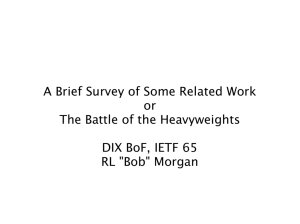
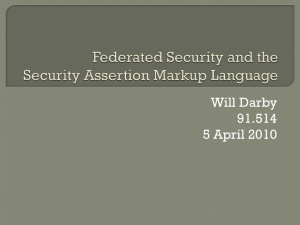
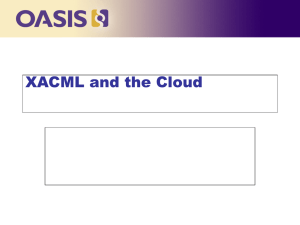
![[#SSPCPP-641] add ability to set SOAP client protocols and cipher](http://s3.studylib.net/store/data/007524050_2-01fcbefd1bbaa532824fc82d6f4c29d0-300x300.png)
